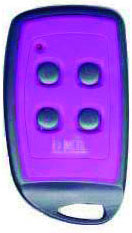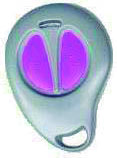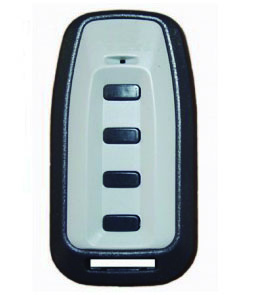FIND YOUR REMOTE
Find your remote and compatable JMA Remote to copy
Frequency
Type of code
- Fixed. The code emitted by the remote control, is always the same. There is no encryption and once the remote control is duplicated, the copy works directly in the receiver.
- Rolling. The code emitted by the remote control, changes with each pulse. A copy of the remote control should be made, that way generating the same brand and model but with a different serial number, that will be necessary for registry in the receiver. There are specific instructions for each receiver of either how to register the copy, remotely or directly manipulating the receiver.
Buttons
Auto-Programmable The remote control can be registered in the receiver without the need of the original remote control, as long as radio communication is activated and the memory is not full.
PROCESS:
- In front of the receiver keep the JMA remote control pressed during 10 seconds until the red LED goes off (after 4 seconds) and it turns to green (at 10 seconds).
- Once the LED is green, release the button and wait for the LED to definitely go off. During the process, the green LED will flash once or several times depending on the code type until finally going off.
If the process does not work, test the standard method using the original remote control or gaining access directly from the receiver.
Copy
No copy
SYNCHRONISING GO ROLLING CODE REMOTE CONTROLS
The GO remote control is synchronised directly with the receiver the first time the button is pressed. However, this option is disabled on some models, which must be synchronised manually.
GO remote control manual synchronisation procedure
1. Open the receiver and locate a switch or pushbutton labelled \"PROG\".
2. Press the button or turn on the switch.
3. Within ten (10) seconds of the beep, press the button on the device to be synchronised.
The receiver will emit another short beep to indicate that the remote control has been synchronised.
If the receiver fails to synchronise the device (does not emit the short beep) it may mean that the memory is full and the remote control cannot be synchronised without the installer\'s permission.
4. After 10 seconds the receiver will exit synchronisation mode and emit 2 short beeps.
Observations
If the procedure fails, it may mean that the receiver memory is full and impedes synchronisation of new devices without the installer\'s permission.
DMIL® NEO
- F 433,92
- C ROLLING CODE
- B 1,2,3,4
- AP YES
- M-BT / SIMPLY FR1

SYNCHRONISING JCM ROLLING CODE REMOTE CONTROLS
The JCM rolling code remote control synchronisation procedure is identical for all models except the 868 MHz.
There are 3 synchronisation procedures for these devices.
PIN-MODE remote synchronising procedure
The following procedure must be applied if the receiver bears the words PIN-MODE:
1. Stand near the receiver and use a pointed object to press the pushbutton at the rear of the remote control to be synchronised.
The receiver will emit a long beep, indicating that the device has been successfully synchronised.
Remote synchronisation procedure using the original remote control
1. Stand near the receiver and use a pointed object to press the pushbutton at the rear of the synchronised remote control.
The receiver will emit a beep, indicating that it has switched to synchronisation mode.
2. Within 10 seconds of the beep, press the button on the device to be synchronised.
The receiver will emit another short beep to indicate that the remote control has been synchronised.
If the receiver fails to synchronise the device (does not emit the short beep) it may mean that the memory is full and the remote control cannot be synchronised without the installer\'s permission.
3. After 10 seconds the receiver will exit synchronisation mode and emit 2 short beeps.
Direct synchronisation procedure on the receiver
1. Open the receiver and locate a switch or pushbutton labelled \"PROG\".
2. Press the button or turn on the switch.
The receiver will emit a long beep and the LED will light up. From this point, follow the previous procedure from step 2 above.
DMIL® TWIN
- F 433,92
- C ROLLING CODE
- B 2
- AP YES
- M-BT / SIMPLY FR1

SYNCHRONISING JCM ROLLING CODE REMOTE CONTROLS
The JCM rolling code remote control synchronisation procedure is identical for all models except the 868 MHz.
There are 3 synchronisation procedures for these devices.
PIN-MODE remote synchronising procedure
The following procedure must be applied if the receiver bears the words PIN-MODE:
1. Stand near the receiver and use a pointed object to press the pushbutton at the rear of the remote control to be synchronised.
The receiver will emit a long beep, indicating that the device has been successfully synchronised.
Remote synchronisation procedure using the original remote control
1. Stand near the receiver and use a pointed object to press the pushbutton at the rear of the synchronised remote control.
The receiver will emit a beep, indicating that it has switched to synchronisation mode.
2. Within 10 seconds of the beep, press the button on the device to be synchronised.
The receiver will emit another short beep to indicate that the remote control has been synchronised.
If the receiver fails to synchronise the device (does not emit the short beep) it may mean that the memory is full and the remote control cannot be synchronised without the installer\'s permission.
3. After 10 seconds the receiver will exit synchronisation mode and emit 2 short beeps.
Direct synchronisation procedure on the receiver
1. Open the receiver and locate a switch or pushbutton labelled \"PROG\".
2. Press the button or turn on the switch.
The receiver will emit a long beep and the LED will light up. From this point, follow the previous procedure from step 2 above.

